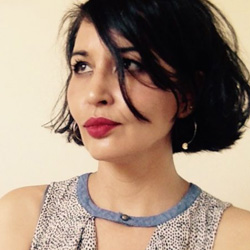But
is the small way to begin.
But I could not.
As I am limited to few
words at command, such as wanblí. This
was how I wanted to begin, with the little
I know.
But could not.
Because this wanblí, this eagle
of my imagining is not spotted, bald,
nor even a nest-eagle. It is gold,
though by definition, not ever the great Golden Eagle.
Much as the gold, by no mistake, is not ground-gold,
man-gold or nugget. But here, it is
the gold of light and wing together.
Wings that do not close, but in expanse
angle up so slightly; plunge with muscle
and stout head somewhere between
my uncle, son, father, brother.
But I failed to begin there, with this
expanse. Much as I failed to start
with the great point in question.
There in muscle in high inner flight always
in the plunge we fear for the falling, we buckle to wonder:
What man is expendable?
Notes on the Poem
Another section of Layli Long Soldier's poem "He Sápa" from her 2018 Griffin Poetry Prize shortlisted collection Whereas was also a Poem of the Week selection. We found it powerful and provocative. Using different but equally subtle effects, we find "Four" haunting and holding our attention, too. As we mentioned previously, Long Soldier takes as her inspiration for this five-part poem an isolated mountain range in South Dakota. Translated from the Lakota words Pahá Sápa, the mountains known as The Black Hills appeared dark from a distance, as they were covered in trees (as described here). This poem section seems to want to start at something, then stops ... "But I could not." ... then starts, then stops again. "But could not." With what is the poem's narrator struggling? What modest but hopeful "small way to begin" is being thwarted? What might be stymying the reader from discerning what the narrator is trying to communicate? We observed in the previous section of "He Sápa" that how Long Soldier assembled words on the page literally compelled readers to change their perspective. Could that be happening here, too? In fact, a simple change in the text alignment from perhaps more customary left alignment - easy to scan because the beginning of each line has a common starting point - to a more disruptive right alignment could be the key. As this article on visual aesthetics in text layout contends:"When you right align your paragraph, you’re creating a sagged, rusty saw-edge that the reader is supposed to use to start each line of your text. Not easy. This also happens when you center content. When you create this jagged edge, readers can lose their place easier, and it creates a visual blockade for the mind."We would contend, however, that making your way down the "jagged edge" of this poem segment rewards the determined reader, with such gorgeousness as: "Wings that do not close, but &nsbp; in expanse angle up so slightly" and such ultimately empowering words as: "we buckle to wonder: What man is expendable?"
